 So I loaded up the Winchester Model 1885 Traditional Hunter’s Deluxe with Blackhills Ammunition 38-55 255 grain flat nose ammo and fired a shot that went 1,331 fps over the chronograph. The rifle shrugged, as though it barely noticed, the muzzle of the 28″ barrel barely coughed, burped and didn’t rise at all. The steel recoil plate contact on my shoulder was barely noticeable.
So I loaded up the Winchester Model 1885 Traditional Hunter’s Deluxe with Blackhills Ammunition 38-55 255 grain flat nose ammo and fired a shot that went 1,331 fps over the chronograph. The rifle shrugged, as though it barely noticed, the muzzle of the 28″ barrel barely coughed, burped and didn’t rise at all. The steel recoil plate contact on my shoulder was barely noticeable.
Three more shots were taken at a 100 yard target with the rifle set in a sled. Reading glasses were put on to best see the precision v notch in the semi buckhorn sights and post mounted from brass bead, while still seeing an orange smudge of a bullseye down range and I shot the best open sight group I have attempted in ten years.
Yes, I am sure there is an eighteen year old out there who routine shoots better, and forty year old liars who claim the same but, for me, this was as rewarding as the baby backs I smoked last week. One inch grid, 3/4″ group, which I would attribute to the Winchester 1885’s quality of assembly, preciseness of bore, a super long sight radius, and a well supported rifle.
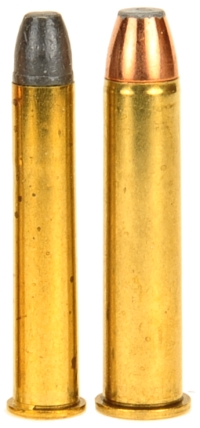 It dawned on me that there was a lot more in the rifle, the cartridge had an excellent potential for hunting, so it deserved greater attention than working up handloads as though it were an original Winchester Model 1885. For me, the 38-55 Winchester is a lot like the 45-70 Government. Both cartridges original loads were for weak designs and materials and do not take into consideration more modern firearms and upgraded materials, however, handloaders over the years have.
It dawned on me that there was a lot more in the rifle, the cartridge had an excellent potential for hunting, so it deserved greater attention than working up handloads as though it were an original Winchester Model 1885. For me, the 38-55 Winchester is a lot like the 45-70 Government. Both cartridges original loads were for weak designs and materials and do not take into consideration more modern firearms and upgraded materials, however, handloaders over the years have.
Manufacturers saw the potential, but had no solution to the problem of people who might ignore the warnings that accompanied more powerful ammunition and might shoot high performance ammunition in original, early firearms or in firearms with a less than substantial design. So the manufacturers tact was to create new cartridges that could not or would not be fired in early or weak firearms.
For the 45-70 Government, the solution was the belted and shortened 450 Marlin and the use of better materials, processes and modest revisions to design. The same applied to the 38-55 WCF with the introduction of the shorter 375 Winchester cartridge and Winchester ’94 Big Bore series.
Neither combination was well received as there was a huge installed base of fans of the original cartridges, specialty ammunition makers producing high performance version of the original cartridges and handloaders who were routinely outperforming the new cartridges with the originals.
The modern Winchester Model 1885 in comparison to the original Model 1885s, is made from high grade steel, with much improved process control and the model is routinely chambered for high intensity cartridge like the 300 Winchester Magnum with a SAAMI MAP of 54,000 CUP. The 38-55 WCF MAP is 30,000 CUP and the 375 Winchester has a MAP of 52,000 CUP. As there really is no correlation between CUP and PSI, I referenced CUP standards to retain an apple to apple pressure comparison. As an example the MAP for the 300 Winchester by transducer method is 64,000 PSI. Neither the 38-55 WCF or 375 Winchester are assigned a MAP PSI.
International standards group CIP does rate all cartridges referenced in BAR with Ptmax standards of: 300 Winchester Magnum 4300 BAR, 38-55 WCF 2400 BAR, 375 Winchester 3800 BAR and bar can be converted to PSI reliably. One psi equals 0.068 bar and one bar equals approximately 14.50 psi. So now we can find a common denominator to use for calculations, as well as for strain and transducer measurement equipment in a more common nomenclature… Winchester 300 Magnum MAP 62,000 PSI, 38-55 WCF 35,000 PSI and 375 Winchester 55,000 PSI.
Why all of the mind numbing minutia? It is always good to present the rational for operating outside of conventions so others can see it, judge it and agree and use the information or discard and rush to social media to express the opinion. The handload data for the 38-55 WCF that follows falls into the 40,000 PSI +/- category. It is a level for use in the modern Winchester 1885 equipped with open sights, with shots taken at relatively close distances, for clean kills on deer size game. Why not push further? If I wanted a powerful, long range Model 1885, it would seem more reasonable to purchase a High Wall Hunter with any of thirteen more powerful cartridge chambers intended for this level of performance.
Background and a little context
 Pictured, left, the 38-55 Winchester next to its hot rod offspring, the 30-30 WCF. In 1895, Winchester necked the 38-55 Winchester down to 30 caliber and introduced the 30-30 Winchester, or 30 Winchester as it is also referred. The 38-55 Winchester continued on in production, ending its first run in 1940. In 2005, the 38-55 Winchester was reintroduced as part of the Winchester Model 1894 line up for its historical significance, primarily in support of cowboy action shooters.
Pictured, left, the 38-55 Winchester next to its hot rod offspring, the 30-30 WCF. In 1895, Winchester necked the 38-55 Winchester down to 30 caliber and introduced the 30-30 Winchester, or 30 Winchester as it is also referred. The 38-55 Winchester continued on in production, ending its first run in 1940. In 2005, the 38-55 Winchester was reintroduced as part of the Winchester Model 1894 line up for its historical significance, primarily in support of cowboy action shooters.
As originally designed, the .38-55 was a true 38 caliber with a groove diameter of 0.380″. Early Ballard, Marlin and Winchester firearm barrels measured between 0.377″ to 0.381″, with each manufacturer putting a slightly different spin on specs and tolerances. The current SAAMI barrel specifications for the 38-55 Winchester are 0.373″ bore and 0.379″ groove. Modern Winchester Model 1894 38-55 Winchester firearms have a bore diameter of 0.368″ and groove diameter of 0.375″.
The SAAMI bullet specification is 0.377″ +0/-0.003″. Winchester jacketed ammunition is loaded with 0.375″ bullets. Other factory ammunition is loaded with 0.377″ cast bullets. Buffalo Bore’s Heavy 38-55 Winchester jacketed ammo is loaded with 0.377″ bullets. All of this ammunition is within SAAMI bullet diameter specification and all are approved for use in the modern Winchester Model 1894 firearms by Winchester or recommended by the ammunition manufacturer.
For the handloader, cast bullets for the 38-55 Winchester are produced in diameters from 0.375″ to 0.380″ which permits matching bullets to groove diameter of basically any 38-55 Winchester chambered firearm. However, jacketed bullets are typically either 0.375″ or 0.377″ with most 0.375″
The other differences within .375 caliber bullets…
Bullets L-R Pull from Black Hills 38-55 WCF 255 grain ammunition. Sierra ProHunter 200 grain flat nose designed for the 375 Winchester and 2,200 fps velocity. Hornady Soft Point 225 grain soft point designed for the 376 Steyr. Speer 235 grain Semi-Spitzer designed for the 375 H&H. Barnes Original 255 grain flat nose intended for the 38-55 WCF and is 0.377″ diameter.
Because of the differences in intended applications, cannelure position varies which varies the length of the bullet nose that extends forward. Consequently, the use of some result in a cartridge overall length that exceeds SAAMI maximum length, a length that would not cycle through a Model ’94 rifle chambered for the 38-55 WCF. Additionally, many .375 caliber bullets are spire tipped and can’t be used in tubular magazine rifles. Fortunately, the Winchester Model 1885’s chamber and freebore dimensions permit longer than spec cartridge overall length and a round, flat nose or spire tipped bullet form may all be used in the single shot Model 1885. Table below, jacketed bullets as they appear left to right above, in top to bottom order below.
| Bullet | Type | Diameter” | Weight Grains |
Length” | Cartridge COL ” |
| Sierra ProHunter | FNSP | 0.375 | 200 | 0.840 | 2.500 |
| Hornady | SP | 0.375 | 225 | 1.128 | 2.780 |
| Speer Hot-Cor | SSSP | 0.375 | 235 | 1.056 | 2.750 |
| Barnes Original | FBSP | 0.377 | 255 | 1.027 | 2.470 |
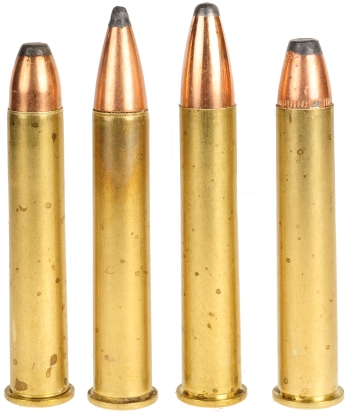
Handload Notes and the bullet falls through conundrum
Pictured below – No, that is not a new flat nose bullet. The intent is to illustrate that die sets accommodate 0.377″ 38-55 WCF bullets and 0.375″ bullets, while providing proper neck tension on both. That is an inverted 0.375″ bullet that stands no chance of casually dropping into the sized case.
I don’t know how many times I have seen people indicate that they solve the problem of inadequate case tension by reducing the size of the expander ball in their sizer die. The 38-55 WCF is a straight wall case, so sizer dies generally do not use an expander ball. Instead, they use an independent expander die with an internal mandrel and a die forming surface to expand the case and flare the case mouth, the latter mostly useful for cast bullets.
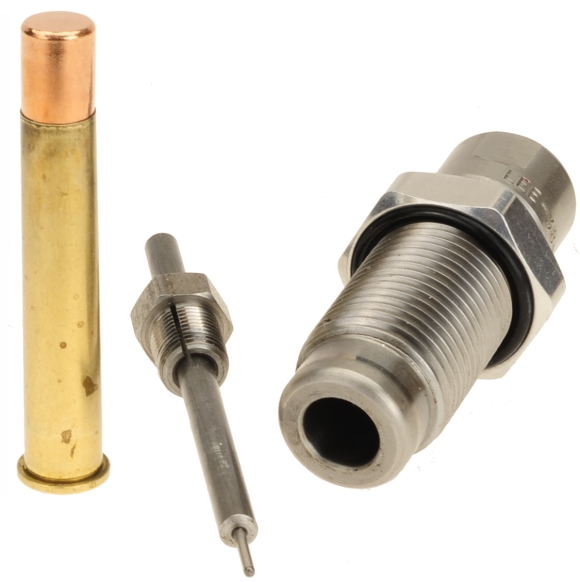
For the handloads below, cases were full length sized and passed through the expander die for 0.377″ bullets. For 0.375″ bullets, the cases were full length resized, the case mouths were inside/outside reamed and the expander step was skipped. Fired cases from the Winchester 1885 measured 0.375″ ID at the mouth and 0.367″ after sizing. The heel on the jacketed bullets provided enough tapered lead to seat without damaging the thin case and the case tension was more than adequate to retain bullet position.
Hornady does not make a modified case for checking COL, but modified cases are easy enough to make, detail here. Good insurance to have when exceeding spec lengths and want to check rifling clearance.
The bullets selected are not intended to be optimal, but they permitted load work up for a variety of bullet weights. An excellent source of 0.375″ and 0.377″ bullets is Hawk Bullets in round and flat nose and Spire tip. Jacket thickness and cannelure location are correct for the 38-55 WCF and weight run from 200 grains to 300 grains. Jacket thickness runs from 0.025″ to 0.035″ and the copper jackets allow maximum expansion at 38-55 WCF velocity without coming apart.
Warning: Bullet selections are specific, and loads are not valid with substitutions of different bullets of the same weight. Variations in bullet length will alter net case capacity, pressure and velocity. Primer selection is specific and primer types are not interchangeable. These are maximum loads in my firearms and may be excessive in others. All loads should be reduced by 5% as a starting point for development where cartridges have greater than 40 grains in capacity and 10% for cartridges with less than 40 grain capacity following safe handloading practices as represented in established mainstream reloading manuals. Presentation of these loads does not constitute a solicitation for their use, nor a recommendation.
| 38-55 Winchester 35,000 PSI – 40,000 PSI Exceeds SAAMI Standard Pressure |
|
| Firearm | Winchester 1885 |
| Barrel Length | 28.00″ |
| Max Case Length | 2.085″ +0.000″/-0.020″ |
| Min – Max COL | 2.470″ – 2.510″ |
| Primer | Remington 9 1/2 (LR) |
| Bullet Diameter | 0.3770″ +0.000″/-0.0030″ |
| Reloading Dies | Lee Precision |
| Bullet Type | Bullet Weight Grains |
Net H2O Grains Capacity |
COL” | Powder Type | Powder Charge Grains |
Muzzle Velocity fps |
Muzzle Energy ft/lbs |
| Sierra Pro-Hunter FN | 200 | 40.4 | 2.500 | H322 | 38.5 | 2330 | 2412 |
| Sierra Pro-Hunter FN | 200 | 40.4 | 2.500 | H335 | 41.0 | 2333 | 2418 |
| Sierra Pro-Hunter FN | 200 | 40.4 | 2.500 | Re 7 | 35.0 | 2341 | 2434 |
| Sierra Pro-Hunter FN | 200 | 40.4 | 2.500 | Re 10 | 37.5 | 2398 | 2554 |
| Hornady SP | 225 | 32.6 | 2.780** | Benchmark | 38.0 | 2154 | 2319 |
| Hornady SP | 225 | 32.6 | 2.780** | H335 | 35.0 | 2216 | 2238 |
| Hornady SP | 225 | 32.6 | 2.780** | Re 7 | 34.0 | 2148 | 2306 |
| Hornady SP | 225 | 32.6 | 2.780** | RS x-Terminator | 40.0 | 2157 | 2325 |
| Speer Hot Core SP |
235 | 34.2 | 2.750** | H322 | 37.5 | 2122 | 2350 |
| Speer Hot Core SP | 235 | 34.2 | 2.750** | H335 | 40.0 | 2159 | 2433 |
| Speer Hot Core SP | 235 | 34.2 | 2.750** | Re 7 | 34.0 | 2138 | 2386 |
| Speer Hot Core SP |
235 | 34.2 | 2.750** | Re 10x | 36.0 | 2148 | 2408 |
| Barnes Original* FNSP |
255 | 34.0 | 2.470 | H322 | 32.0 | 1868 | 1976 |
| Barnes Original* FNSP |
255 | 34.0 | 2.470 | H335 | 35.0 | 1844 | 1926 |
| Barnes Original* FNSP |
255 | 34.0 | 2.470 | Re 7 | 29.0 | 1900 | 2045 |
| Barnes Original* FNSP |
255 | 34.0 | 2.470 | Re 10x | 31.5 | 1927 | 2103 |
| *0.377″ bullet diameter **Exceeds SAAMI Cartridge Overall Length | |||||||
The Winchester Model 1885 single shot edge
From the Real Guns® Ballistics Calculator –
| Cast 255 Grain – Standard Velocity | |||||||
| Near-Zero – yds. | 12 | Mid Range – yds. | 62 | ||||
| Far-Zero – yds. | 110 | Max Ordinate – in. | +3.0 | ||||
| Point Blank – yds. | 117 | ||||||
| Best Zero : Range 0 – 300 yards | ||||||||||||
| Yards | 0 | 50 | 100 | 150 | 200 | 250 | 300 | |||||
| Velocity – fps | 1331 | 1219 | 1128 | 1057 | 1002 | 957 | 919 | |||||
| Energy – ft.-lbs. | 1003 | 841 | 720 | 633 | 568 | 519 | 478 | |||||
| Momentum – lbs-sec | 48 | 44 | 41 | 39 | 36 | 35 | 33 | |||||
| Path – in. | -1.50 | 2.71 | 1.08 | -7.38 | -23.61 | -48.48 | -82.85 | |||||
| Drift – in. | 0.00 | 0.00 | 0.00 | 0.00 | 0.00 | 0.00 | 0.00 | |||||
| Time Of Flight – sec. | 0.00 | 0.12 | 0.25 | 0.38 | 0.53 | 0.68 | 0.84 | |||||
Loaded to SAAMI spec pressure levels, and with 255 grain flat nose cast bullets and COL suitable for lever action firearms, the Winchester 1885 is easy going, fun to shoot, but quite limited in range due to a steep trajectory curve and low retention of velocity and kinetic energy.
| Sierra 200 Grain FNSP | |||||||
| Near-Zero – yds. | 21 | Mid Range – yds. | 106 | ||||
| Far-Zero – yds. | 184 | Max Ordinate – in. | +3.0 | ||||
| Point Blank – yds. | 195 | ||||||
| Best Zero : Range 0 – 300 yards | ||||||||||||
| Yards | 0 | 50 | 100 | 150 | 200 | 250 | 300 | |||||
| Velocity – fps | 2398 | 2187 | 1987 | 1798 | 1622 | 1463 | 1321 | |||||
| Energy – ft.-lbs. | 2553 | 2123 | 1753 | 1436 | 1168 | 950 | 775 | |||||
| Momentum – lbs-sec | 69 | 62 | 57 | 51 | 46 | 42 | 38 | |||||
| Path – in. | -1.50 | 1.64 | 2.97 | 2.08 | -1.51 | -8.41 | -19.38 | |||||
| Drift – in. | 0.00 | 0.00 | 0.00 | 0.00 | 0.00 | 0.00 | 0.00 | |||||
| Time Of Flight – sec. | 0.00 | 0.07 | 0.14 | 0.22 | 0.30 | 0.40 | 0.51 | |||||
Loaded to 40,000 PSI +/- even a flat nose, lighter weight 200 grain bullet with the streamlining of a brick can tack on 78 point blank yards with a maximum ordinate of +3″ and deliver the same kinetic energy at 225 yards that the original cartridge could deliver at the muzzle.
| Hornady 225 Grain Soft Point | |||||||
| Near-Zero – yds. | 20 | Mid Range – yds. | 104 | ||||
| Far-Zero – yds. | 183 | Max Ordinate – in. | +3.0 | ||||
| Point Blank – yds. | 195 | ||||||
| Best Zero : Range 0 – 300 yards | ||||||||||||
| Yards | 0 | 50 | 100 | 150 | 200 | 250 | 300 | |||||
| Velocity – fps | 2216 | 2092 | 1972 | 1856 | 1745 | 1638 | 1538 | |||||
| Energy – ft.-lbs. | 2453 | 2186 | 1943 | 1721 | 1521 | 1340 | 1182 | |||||
| Momentum – lbs-sec | 71 | 67 | 63 | 60 | 56 | 53 | 49 | |||||
| Path – in. | -1.50 | 1.74 | 2.99 | 2.00 | -1.51 | -7.88 | -17.49 | |||||
| Drift – in. | 0.00 | 0.00 | 0.00 | 0.00 | 0.00 | 0.00 | 0.00 | |||||
| Time Of Flight – sec. | 0.00 | 0.07 | 0.14 | 0.22 | 0.31 | 0.39 | 0.49 | |||||
Using more of the potential of the Winchester 1885 single shot’s potential and moving to a spire tipped bullet, a 235 grain pointed bullet has about the same flattened trajectory as a lighter 200 grain flat nose bullet, but with greater velocity and energy retention. In this case, the 235 grain bullet can deliver higher velocity and kinetic energy beyond 300 yards than the standard cartridge can produce at the muzzle and at 75 yards more than the high velocity 200 grain flat nose.
Conclusions? Sure. Why not…
The most obvious feature of the Winchester Model 1885 Traditional Hunter Deluxe is its accuracy and good looks. The latter is sometimes accomplished by others, but not so much the former. A contingency of shooters will appreciate the tang mounted peep sight, the old time deeply blued hex barrel and the chem color case hardened receiver and hardware finish. The same folks will probably grow a beard, wear a period stetson or newsboy cap and shoot cast bullet factory ammo. The more power to them as the rifle will be easy shooting and deliver all the accuracy their own marksmanship skills will allow.
Another group of shooter will appreciate the same, mount a scope and grant a reprieve to… mature eyes and squeeze more accuracy out of the rifle. Great range rifle or deer rifle.
Another group will appreciate the same as the other, have respect for the firearm’s John Browning design and Winchester heritage, but will keep in mind it is a firearm of very modern manufacturer and process and bring cartridge performance closer to the rifle’s potential. I think it would make a heck of a hunting rifle; deer, black bear, elk, hogs, etc. Let’s just call it a very nice firearm.

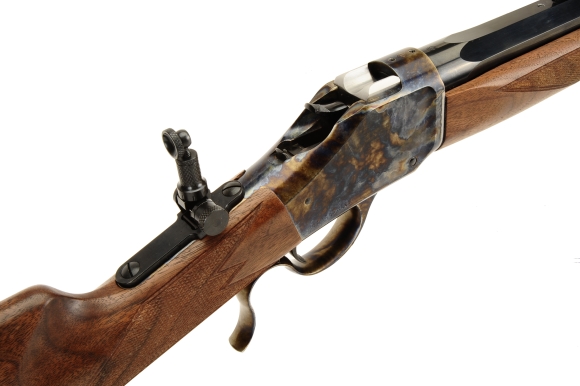
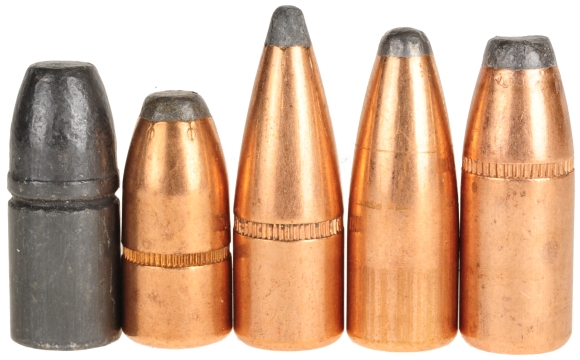

Email Notification